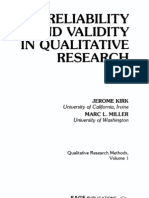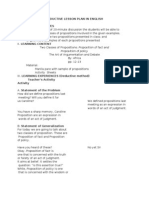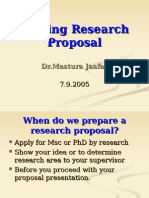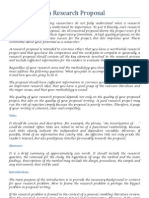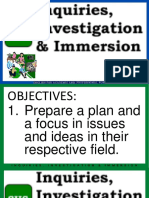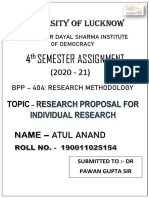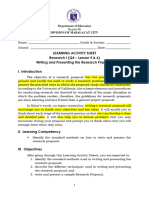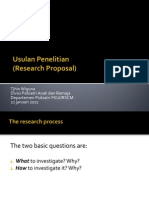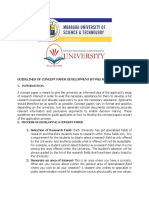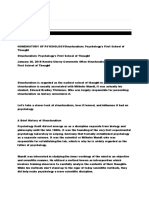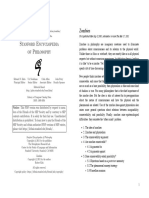0 ratings0% found this document useful (0 votes)
49 viewsRWD Lecture 04
RWD Lecture 04
Uploaded by
kyla mae tatoyThis document provides an overview of key components to include in a research proposal. It discusses the purpose and importance of the research proposal, then outlines a typical contents list including background, problem, objectives, literature review, methodology, ethical issues, and timeline. Various methods for expressing the research problem are presented, such as using aims, research questions, or hypotheses. The document also provides examples and activities to help the reader practice formulating these components for their own research topic.
Copyright:
© All Rights Reserved
Available Formats
Download as PPT, PDF, TXT or read online from Scribd
RWD Lecture 04
RWD Lecture 04
Uploaded by
kyla mae tatoy0 ratings0% found this document useful (0 votes)
49 views22 pagesThis document provides an overview of key components to include in a research proposal. It discusses the purpose and importance of the research proposal, then outlines a typical contents list including background, problem, objectives, literature review, methodology, ethical issues, and timeline. Various methods for expressing the research problem are presented, such as using aims, research questions, or hypotheses. The document also provides examples and activities to help the reader practice formulating these components for their own research topic.
Original Description:
tyutol
Copyright
© © All Rights Reserved
Available Formats
PPT, PDF, TXT or read online from Scribd
Share this document
Did you find this document useful?
Is this content inappropriate?
This document provides an overview of key components to include in a research proposal. It discusses the purpose and importance of the research proposal, then outlines a typical contents list including background, problem, objectives, literature review, methodology, ethical issues, and timeline. Various methods for expressing the research problem are presented, such as using aims, research questions, or hypotheses. The document also provides examples and activities to help the reader practice formulating these components for their own research topic.
Copyright:
© All Rights Reserved
Available Formats
Download as PPT, PDF, TXT or read online from Scribd
Download as ppt, pdf, or txt
0 ratings0% found this document useful (0 votes)
49 views22 pagesRWD Lecture 04
RWD Lecture 04
Uploaded by
kyla mae tatoyThis document provides an overview of key components to include in a research proposal. It discusses the purpose and importance of the research proposal, then outlines a typical contents list including background, problem, objectives, literature review, methodology, ethical issues, and timeline. Various methods for expressing the research problem are presented, such as using aims, research questions, or hypotheses. The document also provides examples and activities to help the reader practice formulating these components for their own research topic.
Copyright:
© All Rights Reserved
Available Formats
Download as PPT, PDF, TXT or read online from Scribd
Download as ppt, pdf, or txt
You are on page 1of 22
Lecture 4
THE RESEARCH PROPOSAL
Lecture 4
LEARNING OBJECTIVES
to appreciate the nature and the importance
of the research proposal
to know how to put together the contents of
the research proposal
to understand the important issues involved
in the research
Lecture 4
LECTURE OUTLINE
recommended reading
the purpose of the research proposal
the importance of the research proposal
a headline contents list of the research proposal
expressing your research as
aims
research questions
hypotheses
setting out the stages of your research
Recommended reading:
Chapter 4: The Research Proposal, in the associated book:
Horn, R. (2009) Researching and Writing Dissertations.
London: CIPD
THE RESEARCH PROPOSAL
The research proposal is the key gateway
document to your dissertation. It sets out the
main details of how your research will be
conducted.
In many universities the dissertation cannot
be progressed until a supervisor has been
allocated and the research proposal agreed
between student and supervisor.
It is also a key document in formulating and
crystallising your topic ideas into a do-able
dissertation.
The research proposal:
PURPOSE
Organising and developing your topic ideas
Testing the scope of the research
Identifying an appropriate supervisor
Convincing other people of the merit of your idea
Initiating the research process
Obtaining support and early access rights
Being a basis on which to develop your research
The research proposal:
CONTENTS
1 Title
2 Background to the research
3 The research problem
4 The objectives of the research
5 Literature
6 Methodology
7 Ethical issues
8 Access issues
9 Time-scale.
10 Bibliography
The research problem:
THE AIM STATEMENT
An aim statement is a common way to express the research problem. It is
to give an example normally of the form:
The aim of this research is to investigate absence at SEDO Ltd.
Note that this is still a fairly loose statement of aim. This aim can be
tightened by further specifying the following:
the place of research
the guiding theory for the research
the type of study quantitative or qualitative
the method for example, a comparative study, a case study, etc.
The aim above could now become A qualitative case investigation of
absence at SEDO Ltd, using Steers and Rhodes (1978) notion of the
ability to attend.
Using an aim statement to specify a research problem works well when
the research is of a broad, exploratory or investigative nature.
Work-alone activity:
AN AIM STATEMENT
Time allowed: 10 minutes preparation
2 minutes feedback
Using your own research ideas, express them in the
form of an aim statement.
You may need to try this a few times to achieve the
required detail and precision.
Feedback to the group: The aim of my research is . . .
The research problem:
RESEARCH QUESTIONS
Using research questions is a more specific way to state the research
problem.
The normal arrangement is to list a number of questions that the
research will answer, such as:
RQ1 What are the current attendance levels at SEDO Ltd?
RQ2 What is the pattern of absence for individual employees (using
the Bradford factor to measure this absence)?
RQ3 What aspects of the work design is affecting absence at SEDO
Ltd?
RQ4 What are the employee issues around ability to attend?
RQ5 What aspects are reported that lie outside the Steers and
Rhodes (1978) absence model?
Using this method expresses your research problem in a much
tighter manner from the start, and is suitable where you have a clear
set of issues arising from the literature that addresses the research
problem.
Work-alone activity:
RESEARCH QUESTIONS
Time allowed: 15 minutes preparation
3 minutes feedback
Using your own research ideas, express them in the
form of research questions.
You may need to try this a few times to achieve the
required detail and precision.
Feedback to the group: My research questions are . . .
The research problem:
HYPOTHESES
The research problem can also be specified using a set of
testable hypotheses a set of logical, reasonable, tentative
explanations of the subject under investigation.
It is normal to reject the null hypothesis (H0) before
testing alternative hypotheses.
The null hypothesis states that the two variables under
consideration occurred solely by chance.
If the null hypothesis is rejected, alternative hypotheses may
be developed.
The research problem:
HYPOTHESES
Continuing with our example of absence management, the following
hypotheses could be tested (Burton, Lee and Holtom, 2002):
Hypothesis 1: Ability to attend will be positively related to the frequency of
absenteeism that is attributed to family issues.
Hypothesis 2: Ability to attend will be positively related to the frequency of
absenteeism that is attributed to transportation problems.
Hypothesis 3a): Motivation to attend will be negatively related to the
frequency of absenteeism that is attributed to illness.
Hypothesis 3b): Ability to attend will be positively related to the frequency
of absenteeism that is attributed to illness.
Hypothesis 4: Motivation to attend will be negatively related to the
frequency of absenteeism that results in a failure to notify the organisation.
Note that Hypothesis 3 is split into a) and b), in which a) tests the negative
relation and b) tests the positive relation to that factor.
The research problem:
HYPOTHESES
Hypotheses are never proved or disproved. In a research
study it is normal to either support or reject a hypothesis.
For a hypothesis to be rejected would commonly lead to
the substitution of a new hypothesis that is then either
supported or rejected.
If a hypothesis is supported by the data in your study, it
may later be supported by further studies. Eventually, a
hypothesis that is well supported from multiple sources
may be developed into a well-grounded theory. It could be
that your research is testing, in a different context,
hypotheses from earlier research studies.
Work-alone activity:
HYPOTHESES
Time allowed: 15 minutes preparation
3 minutes feedback
Using your own research ideas, express them in the
form of research hypotheses.
You may need to try this a few times to achieve the
required detail and precision.
Feedback to the group: My research hypotheses are . . .
THE OBJECTIVES OF THE RESEARCH
Once the aim of the research has been clearly stated, the next section in the
proposal deals with the detail of how the aim is to be achieved. The
objectives are normally expressed as a set of closely specified statements
that would enable the aim to be achieved.
The objectives are likely to be the milestones of the research as it
progresses, and for a typical dissertation may look like this:
Objective 1 Critically review the literature and development of one
guiding theory.
Objective 2 Develop and pilot the methodology, consistent with the
theoretical framework adopted in Objective 1.
Objective 3 Clarify and define the population for the study, and select
the sample.
Objective 4 Distribute the questionnaires and follow up with a telephone
enquiry for maximum response.
Objective 5 Analyse the data and present the findings.
Objective 6 Make recommendations to improve management practice.
Work-alone activity:
RESEARCH OBJECTIVES
Time allowed: 10 minutes preparation
2 minutes feedback
Using your own research ideas, express them in the
form of research objectives.
You may need to try this a few times to achieve the
required detail and precision.
Feedback to self/supervisor: My research objectives
are . . .
THE LITERATURE REVIEW
At the proposal stage the literature review is likely to be a list of possible
sources related to the research problem. Even at this stage it is important to
be critical and evaluative. The sources must be closely related to the
research you intend to carry out.
Most literature reviews in a research proposal for business topics contain
the following:
1 A critical explanation of three or four main theories that could guide the
research
2 An overview of two or three professional-body websites related to the
research topic
3 Ten to fifteen journal articles relating to the research. These may serve a
number of different uses:
empirical articles related to the research problem
articles that critique or extend the main theories
explanation and critique of methods and their use
articles containing data analysis techniques likely to be used in
the research
4 Secondary data sources related to your research study for example,
ESRC Labour Force Survey
ETHICAL ISSUES
All research has ethical implications and in this section
some thought should be given to the ethical issues of your
research.
In some areas of research such as research involving
children, medical research, psychological research there
are formal procedures to be followed, and ethical
approval is required from an ethics committee.
If you think your research will address one of these
areas or will include any human- or animal-based
research data that may cause harm, you must indicate
this clearly in the research proposal.
Ethical issues:
PERTINENT ETHICAL QUESTIONS
If your research does not require formal approval, your
proposal should address the following questions:
How will the research be designed and undertaken to
ensure integrity and quality?
How will research participants be informed about the
purpose, methods and intended possible uses of
the research?
How will possible risks of participating in the
research be considered?
How will you ensure the confidentiality of the
information supplied by participants, and how will
you assess the need for anonymity?
How will you ensure that participants engage with
your research voluntarily and without coercion?
Work-alone activity:
SCHEDULING MY DISSERTATION
Preparation for the next learning session
Prepare one PowerPoint presentation slide setting
out:
the stages of your research, and how long they are
likely to take to complete
REFLECTION
on the learning points of this lecture
The research proposal is the gateway to your
research.
Develop a clear set of aims and objectives.
If your research warrants it, use research questions
and/or hypotheses.
Consider the ethical implications of your research.
You might also like
- Lecture1 - How To Choose Your Research TopicDocument37 pagesLecture1 - How To Choose Your Research TopicZakariaHasaneen100% (3)
- Reliability and Validity in Qualitative ResearchDocument87 pagesReliability and Validity in Qualitative Researchekchuem100% (3)
- (PsychologyExpress Series) Mark Forshaw, Steven John Jones - Research Methods in Psychology-Prentice Hall (2012)Document214 pages(PsychologyExpress Series) Mark Forshaw, Steven John Jones - Research Methods in Psychology-Prentice Hall (2012)carloseduardomontoyaNo ratings yet
- How To Write A Research ProposalDocument7 pagesHow To Write A Research ProposalMalik SaimaNo ratings yet
- Ludwig Von Bertalanffy GENERAL SYSTEMDocument4 pagesLudwig Von Bertalanffy GENERAL SYSTEMMarielle Acojido100% (3)
- Matson - Why Isn't The Mind-Body Problem AncientDocument16 pagesMatson - Why Isn't The Mind-Body Problem Ancientcarlito_W100% (6)
- It's Not Luck (1994) Is A Business: Novel Manufacturer Eliyahu M. GoldrattDocument2 pagesIt's Not Luck (1994) Is A Business: Novel Manufacturer Eliyahu M. Goldrattpoish1No ratings yet
- Deductive Lesson Plan in EnglishDocument4 pagesDeductive Lesson Plan in EnglishFlorian Mausig89% (65)
- What Constitutes Theoretical Contribution - With ExamplesDocument16 pagesWhat Constitutes Theoretical Contribution - With ExamplesFawad LatifNo ratings yet
- RWD Lecture 04Document22 pagesRWD Lecture 04IvandiNo ratings yet
- Writing Research ProposalDocument20 pagesWriting Research Proposalbadrul79No ratings yet
- Methodology 1 ChinaDocument13 pagesMethodology 1 ChinaErk ContreNo ratings yet
- 4.3 Components of A Research ProposalDocument7 pages4.3 Components of A Research ProposalROGEN MAE DIONIONo ratings yet
- How To Write A Research ProposalDocument8 pagesHow To Write A Research Proposalarjunpandit1984No ratings yet
- How To Write A Research ProposalDocument5 pagesHow To Write A Research Proposalhuwaina100% (1)
- How To Write A Research ProposalDocument4 pagesHow To Write A Research Proposaldanilo miguelNo ratings yet
- Hasri Qurratu Aini 17322035 UTS EDU RESEARCH-dikonversiDocument19 pagesHasri Qurratu Aini 17322035 UTS EDU RESEARCH-dikonversiHasri Qurratu AiniNo ratings yet
- How To Write A Research ProposalDocument4 pagesHow To Write A Research Proposalharsimran_toorNo ratings yet
- Zulfa Group Presesntation Research ProposalDocument8 pagesZulfa Group Presesntation Research Proposalmichaelurassa666No ratings yet
- Research - Proposal - 1 - .Docx - Filename - UTF-8''Research ProposalDocument5 pagesResearch - Proposal - 1 - .Docx - Filename - UTF-8''Research ProposalAyaz AhmadNo ratings yet
- Chapter 4 - Conceptulizing A Research StudyDocument24 pagesChapter 4 - Conceptulizing A Research Studyrenair ravaloNo ratings yet
- 9-Research Methods 3684 Lecture NineDocument31 pages9-Research Methods 3684 Lecture NineM Hammad ManzoorNo ratings yet
- English 10 Week 12 13 Fact SheetsDocument4 pagesEnglish 10 Week 12 13 Fact SheetsyvakissNo ratings yet
- Format of Writing Research Proposal (MGT)Document9 pagesFormat of Writing Research Proposal (MGT)abdiidebela76No ratings yet
- How To Write A Research Proposal: Paul T. P. Wong, PH.D., C.PsychDocument5 pagesHow To Write A Research Proposal: Paul T. P. Wong, PH.D., C.PsychshaniquebinNo ratings yet
- Way To Write A Research ProposalDocument5 pagesWay To Write A Research Proposalmahmalrajpot365No ratings yet
- MODULE 3, Research Questions and Research TypesDocument18 pagesMODULE 3, Research Questions and Research TypesHồng NhungNo ratings yet
- Writing Research ProposalDocument22 pagesWriting Research ProposalZubaedah Wiji LestariNo ratings yet
- How To Write A Reseach PaperDocument5 pagesHow To Write A Reseach Papershahabjani9610No ratings yet
- How To Write A Research ProposalDocument4 pagesHow To Write A Research ProposalOmer UsmanNo ratings yet
- Lesson 1Document9 pagesLesson 1ERLINDA PALACIONo ratings yet
- Components of ResearchDocument5 pagesComponents of ResearchNĩhãd MãlįkNo ratings yet
- Research MethodologyDocument8 pagesResearch Methodologylayla akkoumehNo ratings yet
- 3is Quarter1 Week-1 BINHS PDFDocument41 pages3is Quarter1 Week-1 BINHS PDFFlor Morales BulusanNo ratings yet
- SOC 302 NotesDocument8 pagesSOC 302 NotesDanielNo ratings yet
- How To Write A Good Research - ProposalDocument36 pagesHow To Write A Good Research - ProposalEngineer MustafaNo ratings yet
- Research Proposal CanadaDocument4 pagesResearch Proposal CanadaCynthia AlvarezNo ratings yet
- The 321-Undergraduate Thesis 1Document114 pagesThe 321-Undergraduate Thesis 1ERLINDA PALACIONo ratings yet
- University of Lucknow: 4 Semester AssignmentDocument8 pagesUniversity of Lucknow: 4 Semester AssignmentAtul AnandNo ratings yet
- Definition of A Research Project ProposalDocument11 pagesDefinition of A Research Project ProposalAbu BasharNo ratings yet
- STE Research 2 W1 LASDocument20 pagesSTE Research 2 W1 LASKhallex ObraNo ratings yet
- What Is ResearchDocument3 pagesWhat Is ResearchFRANCIS EMMANUEL MACATLANGNo ratings yet
- Research Proposal GuidelineDocument14 pagesResearch Proposal Guidelinefikadu diribaNo ratings yet
- Module RESEARCH STATISTICS LOOrinaDocument33 pagesModule RESEARCH STATISTICS LOOrinaFRANCHESKA MACATUNONo ratings yet
- 4+Guidance+Notes+-+Research+Methodology+21 01 21Document17 pages4+Guidance+Notes+-+Research+Methodology+21 01 21Zahid Ali KhanNo ratings yet
- Chapter Three: Research Proposal 3.1. What Is Research ProposalDocument9 pagesChapter Three: Research Proposal 3.1. What Is Research ProposalwubeNo ratings yet
- Queens College Business Research Methods-1Document232 pagesQueens College Business Research Methods-1shigaze habteNo ratings yet
- PR2 Module2Document9 pagesPR2 Module2raeautumn282No ratings yet
- 3is 3rd Quarter ReviewerDocument11 pages3is 3rd Quarter ReviewerHazel Anne TabilNo ratings yet
- Methods of ResearchDocument35 pagesMethods of ResearchJomar morabe100% (3)
- Learning Activity Sheet Research I (Q4 - Lesson 5 & 6) Writing and Presenting The Research ProposalDocument13 pagesLearning Activity Sheet Research I (Q4 - Lesson 5 & 6) Writing and Presenting The Research ProposalRyson De leonNo ratings yet
- Chapter 2: Identifying The Inquiry and Stating The ProblemDocument4 pagesChapter 2: Identifying The Inquiry and Stating The ProblemCelyn GaholNo ratings yet
- Example 1: A Traditional Qualitative Research ProposalDocument4 pagesExample 1: A Traditional Qualitative Research Proposalho_thuy_tien90No ratings yet
- Research Design and Methodology Assignment 20 QuestionsDocument13 pagesResearch Design and Methodology Assignment 20 Questionswondimu lelegoNo ratings yet
- 14.3 Components of A Research Proposal - Research Methods For THDocument9 pages14.3 Components of A Research Proposal - Research Methods For THkoyewubrhanuNo ratings yet
- research Methods ppt 2024Document178 pagesresearch Methods ppt 2024ewunetuabera040No ratings yet
- Metlit-06 Usulan Penelitian (B) - Dr. Dr. Tjhin WIguna, SPKJ (K)Document34 pagesMetlit-06 Usulan Penelitian (B) - Dr. Dr. Tjhin WIguna, SPKJ (K)Laurencia LenyNo ratings yet
- Research Process BBM 502: Aditi Gandhi BBM VTH Sem. 107502Document13 pagesResearch Process BBM 502: Aditi Gandhi BBM VTH Sem. 107502geetukumari100% (1)
- ProposalDocument4 pagesProposalcuachanhdongNo ratings yet
- Lecture 3-Research ProcessDocument22 pagesLecture 3-Research ProcessedwinyapsonNo ratings yet
- Sample Research Thesis WritingDocument43 pagesSample Research Thesis Writingsubs143100% (2)
- GUIDELINES OF CONCEPT PAPER DEVELOPMENT BY PHD APPLICANTSDocument6 pagesGUIDELINES OF CONCEPT PAPER DEVELOPMENT BY PHD APPLICANTSMuletaNo ratings yet
- Chapter IIIDocument28 pagesChapter IIIbirhanukifle10No ratings yet
- guideline bookletDocument21 pagesguideline bookletama.tomcsanyiNo ratings yet
- Research ProposalDocument10 pagesResearch Proposalsarfrazkhalil100% (4)
- Chapter 3 (Final)Document10 pagesChapter 3 (Final)Tsegaye TsegayeNo ratings yet
- Kuhn PopperDocument10 pagesKuhn PopperKunal DebnathNo ratings yet
- Sample Research Method 2Document2 pagesSample Research Method 2Mỹ HạnhNo ratings yet
- And Johnrawl'S Theory Ofjustice: Ezekiel T. Mostiero, JD InstructorDocument21 pagesAnd Johnrawl'S Theory Ofjustice: Ezekiel T. Mostiero, JD InstructorJewel Ishi RomeroNo ratings yet
- Levels of Confidence in System Dynamics ModelingDocument20 pagesLevels of Confidence in System Dynamics Modelingrebelli100% (1)
- The Search For Ultimate Reality: Freedom & DeterminismDocument60 pagesThe Search For Ultimate Reality: Freedom & Determinismjgd65yw5j4No ratings yet
- Introduction To Research, Research Cyclical Process, Research MethodsDocument15 pagesIntroduction To Research, Research Cyclical Process, Research MethodsArch Sylvester Seno MArch-ctmNo ratings yet
- Academic Writing Skills - Paraphrasing and SummarisingDocument21 pagesAcademic Writing Skills - Paraphrasing and SummarisingEllish100% (1)
- Expert Validity ScaleDocument10 pagesExpert Validity ScaleWann SaadNo ratings yet
- Inquiry Is A Learning Process That Motivates You To Obtain Knowledge or Information About PeopleDocument3 pagesInquiry Is A Learning Process That Motivates You To Obtain Knowledge or Information About PeoplePew Face100% (2)
- Types of ValidityDocument4 pagesTypes of Validitydanieljohnarboleda100% (1)
- Psychology Notes: Atkinson and Shiffrin (1968)Document1 pagePsychology Notes: Atkinson and Shiffrin (1968)Hilary YuNo ratings yet
- 4d0e8guidance Self Study Course Faculty Allotment Dated 05092014Document29 pages4d0e8guidance Self Study Course Faculty Allotment Dated 05092014CallMe AbhiNo ratings yet
- So CIA LogyDocument197 pagesSo CIA LogySanthosh RagavNo ratings yet
- Writing Academic Reflection Accessible 2015 PDFDocument2 pagesWriting Academic Reflection Accessible 2015 PDFMeha RajNo ratings yet
- Cognitive PsychologyDocument7 pagesCognitive PsychologyAshu KoolNo ratings yet
- Understanding Habermas: Modern Solutions, Postmodern Problems' Jason L. Powell, University of Salford, UKDocument24 pagesUnderstanding Habermas: Modern Solutions, Postmodern Problems' Jason L. Powell, University of Salford, UKRafael Alejandro Arriaza PeñaNo ratings yet
- Science As StorytellingDocument11 pagesScience As StorytellingMauricio MenaNo ratings yet
- StructuralismDocument4 pagesStructuralismdaniNo ratings yet
- Stanford Encyclopedia of Philosophy: ZombiesDocument17 pagesStanford Encyclopedia of Philosophy: ZombiesPaula CamposNo ratings yet
- Experiential Learning Cycle PDFDocument7 pagesExperiential Learning Cycle PDFAdEsinta GloryNo ratings yet
- Posivitism CriminologyDocument10 pagesPosivitism Criminologyudyotama100% (1)
- In Human HistoryDocument3 pagesIn Human HistoryMa. Kyla Wayne LacasandileNo ratings yet
- Common Misconceptions in Learning MathDocument33 pagesCommon Misconceptions in Learning Mathflory mae gudiaNo ratings yet


